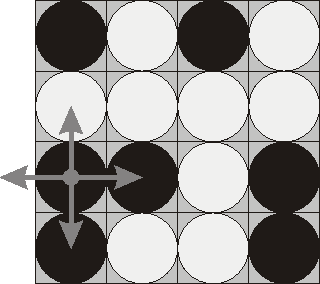poj1753-Flip Game(高斯消元枚举xor线性方程自由变元的值,找为1解的最少数量)
2014-10-05 16:45
661 查看
Flip Game
Description
Flip game is played on a rectangular 4x4 field with two-sided pieces placed on each of its 16 squares. One side of each piece is white and the other one is black and each piece is lying either it's black or white side up. Each
round you flip 3 to 5 pieces, thus changing the color of their upper side from black to white and vice versa. The pieces to be flipped are chosen every round according to the following rules:
Choose any one of the 16 pieces.
Flip the chosen piece and also all adjacent pieces to the left, to the right, to the top, and to the bottom of the chosen piece (if there are any).

Consider the following position as an example:
bwbw
wwww
bbwb
bwwb
Here "b" denotes pieces lying their black side up and "w" denotes pieces lying their white side up. If we choose to flip the 1st piece from the 3rd row (this choice is shown at the picture), then the field will become:
bwbw
bwww
wwwb
wwwb
The goal of the game is to flip either all pieces white side up or all pieces black side up. You are to write a program that will search for the minimum number of rounds needed to achieve this goal.
Input
The input consists of 4 lines with 4 characters "w" or "b" each that denote game field position.
Output
Write to the output file a single integer number - the minimum number of rounds needed to achieve the goal of the game from the given position. If the goal is initially achieved, then write 0. If it's impossible to achieve the
goal, then write the word "Impossible" (without quotes).
Sample Input
Sample Output
Source
Northeastern Europe 2000
| Time Limit: 1000MS | Memory Limit: 65536K | |
| Total Submissions: 31227 | Accepted: 13583 |
Flip game is played on a rectangular 4x4 field with two-sided pieces placed on each of its 16 squares. One side of each piece is white and the other one is black and each piece is lying either it's black or white side up. Each
round you flip 3 to 5 pieces, thus changing the color of their upper side from black to white and vice versa. The pieces to be flipped are chosen every round according to the following rules:
Choose any one of the 16 pieces.
Flip the chosen piece and also all adjacent pieces to the left, to the right, to the top, and to the bottom of the chosen piece (if there are any).

Consider the following position as an example:
bwbw
wwww
bbwb
bwwb
Here "b" denotes pieces lying their black side up and "w" denotes pieces lying their white side up. If we choose to flip the 1st piece from the 3rd row (this choice is shown at the picture), then the field will become:
bwbw
bwww
wwwb
wwwb
The goal of the game is to flip either all pieces white side up or all pieces black side up. You are to write a program that will search for the minimum number of rounds needed to achieve this goal.
Input
The input consists of 4 lines with 4 characters "w" or "b" each that denote game field position.
Output
Write to the output file a single integer number - the minimum number of rounds needed to achieve the goal of the game from the given position. If the goal is initially achieved, then write 0. If it's impossible to achieve the
goal, then write the word "Impossible" (without quotes).
Sample Input
bwwb bbwb bwwb bwww
Sample Output
4
Source
Northeastern Europe 2000
#include<iostream>
#include<map>
#include<string>
#include<cstring>
#include<cstdio>
#include<cstdlib>
#include<cmath>
#include<queue>
#include<vector>
#include<algorithm>
using namespace std;
const int maxn=100;
const int maxm=100;
const int inf=0xfffffff;
int a[maxn][maxm],x[maxm];
int gauss(int n)
{
int row,line,i,j,m,free[maxm],cnt=0,t,mn,sum,k;
for(row=line=0;line<n;row++,line++)
{
i=row;
for(j=row+1;j<n;j++)
if(a[j][line]>a[i][line])
i=j;
if(i!=row)
for(j=row;j<=n;j++)
swap(a[i][j],a[row][j]);
if(a[row][line]==0)
{
free[cnt++]=line;
row--;
continue;
}
for(i=row+1;i<n;i++)
if(a[i][line]==1)
for(j=line;j<=n;j++)
a[i][j]^=a[row][j];
}
for(i=row;i<n;i++)
if(a[i]
==1)
return -1;
mn=inf;
m=1<<cnt;
memset(x,0,sizeof(x));
for(i=0;i<m;i++)
{
t=i;
sum=0;
for(j=0;j<cnt;j++)
{
x[free[j]]=t&1;
if(x[free[j]]==1)
sum++;
t>>=1;
}
for(j=row-1;j>-1;j--)
{
x[j]=a[j]
;
for(k=j+1;k<n;k++)
x[j]^=a[j][k]&x[k];
if(x[j]==1)
sum++;
}
mn=min(sum,mn);
}
return mn;
}
void init(int n)
{
int i,j,t;
memset(a,0,sizeof(a));
for(i=0;i<n;i++)
for(j=0;j<n;j++)
{
t=i*n+j;
a[t][t]=1;
if(i!=0)
a[(i-1)*n+j][t]=1;
if(i!=n-1)
a[(i+1)*n+j][t]=1;
if(j!=0)
a[t-1][t]=1;
if(j!=n-1)
a[t+1][t]=1;
}
}
int main()
{
int i,j,n=4,ans,m=16,t;
char s[maxn][maxm];
while(scanf("%s",s[0])!=EOF)
{
for(i=1;i<n;i++)
scanf("%s",s[i]);
init(n);
for(i=0;i<n;i++)
for(j=0;j<n;j++)
if(s[i][j]=='b')
a[i*n+j][m]=1;
t=gauss(m);
t=t==-1?inf:t;
init(n);
for(i=0;i<n;i++)
for(j=0;j<n;j++)
if(s[i][j]=='w')
a[i*n+j][m]=1;
ans=gauss(m);
ans=ans==-1?inf:ans;
ans=min(ans,t);
if(ans==inf)
printf("Impossible\n");
else
cout<<ans<<endl;
}
}
相关文章推荐
- POJ 1753 Flip Game (高斯消元 枚举自由变元求最小步数)
- poj 1753 Flip Game 【高斯消元 + 状压枚举自由变元】
- poj1753--Flip Game(高斯消元问题2,枚举自由元的首杀)
- 高斯消元 POJ 1222 POJ 1681(枚举自由变元)POJ 1753(两次高斯消元) POJ 1830 HDU 5833 (高斯消元,素数分解)POJ 3158 (集合压缩枚举自由变元)
- POJ 1753 Flip Game 高斯消元 枚举自由变量
- poj 1753 Flip Game 高斯消元+枚举
- POJ 1753 Flip Game(枚举变元的高斯消元)
- POJ 1753 Flip game ( 高斯消元枚举自由变量)
- poj 1681 Painter's Problem 高斯消元 枚举自由变元
- poj 1753 Flip Game(高斯消元)
- POJ 1681 Painter's Problem(高斯消元+枚举自由变元)
- poj 3185 The Water Bowls 【高斯消元 + 枚举自由变元】
- poj 1753 Flip Game 高斯消元
- POJ 1753 Flip Game 高斯消元
- POJ 1753 Flip Game (高斯消元)
- poj 1753 Flip Game(高斯消元)
- poj 1753 Flip Game 高斯消元 异或方程组 求最值
- poj 1753 Flip Game 高斯消元
- poj 1681 Painter's Problem 【高斯消元 枚举自由变元】
- [置顶] POJ 1753 Flip Game(高斯消元入门超详细题解)——Northeastern Europe 2000
